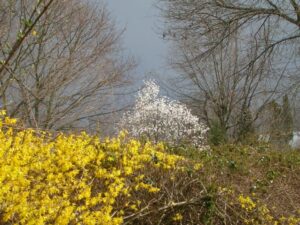Thou still unravish’d bride of quietness,
Thou foster-child of Silence and slow Time….
John Keats, “Ode on a Grecian Urn”
My notion of time is tightly bound to the motion of the Earth around the sun and to the temporal markers that correspond to that motion. Seasons follow a relatively stable pattern with which anyone who lives for a while in the same place can easily tell the approximate progress of the year.
I can manipulate my perception of time, however, by going to a location in which the season is ahead or behind the season I have left. From this manipulation I conclude that time is not only dependent on the rising and setting of the sun but also on the amount of shade, the longitude north or south and elevation.
 I can play with time in the garden by cutting back a flower to make it bloom later. By changing the position of a potted tomato plant, I can make its fruit bloom earlier or later. Like the tomato, I will ripen at a different rate in different settings; my mind is tied to what the senses feed it. Driving in July to Wisconsin, I return to the exhilaration of an Ohio Valley June. If I continue north to Ontario, I can still find May. April and spring beauties wait for me above Lake Louise in the Canadian Rockies. Adjusting time by changing space, I lengthen pleasure, heighten the experience, extend and extend, never satisfied until I reach too far.
I can play with time in the garden by cutting back a flower to make it bloom later. By changing the position of a potted tomato plant, I can make its fruit bloom earlier or later. Like the tomato, I will ripen at a different rate in different settings; my mind is tied to what the senses feed it. Driving in July to Wisconsin, I return to the exhilaration of an Ohio Valley June. If I continue north to Ontario, I can still find May. April and spring beauties wait for me above Lake Louise in the Canadian Rockies. Adjusting time by changing space, I lengthen pleasure, heighten the experience, extend and extend, never satisfied until I reach too far.
One task of my gardening, not unlike my purpose in travel, is to overcome the limits of place, and, understanding the laws of observation, to transcend the sun’s motion, to prolong, to put off transition until I have found the last edge of summer, until I can go no further, can prune back no more, until I have passed the high timberline of time and must finally retreat to memory and to static art in the slow time of winter.
Bill Felker


This entry is indicative of Bill Felker’s beautiful melding of the botanical and verse. Evocative imagery. A literary slow dance.
Pingback: Talking the Walk - Poor Will's Almanack by Bill Felker